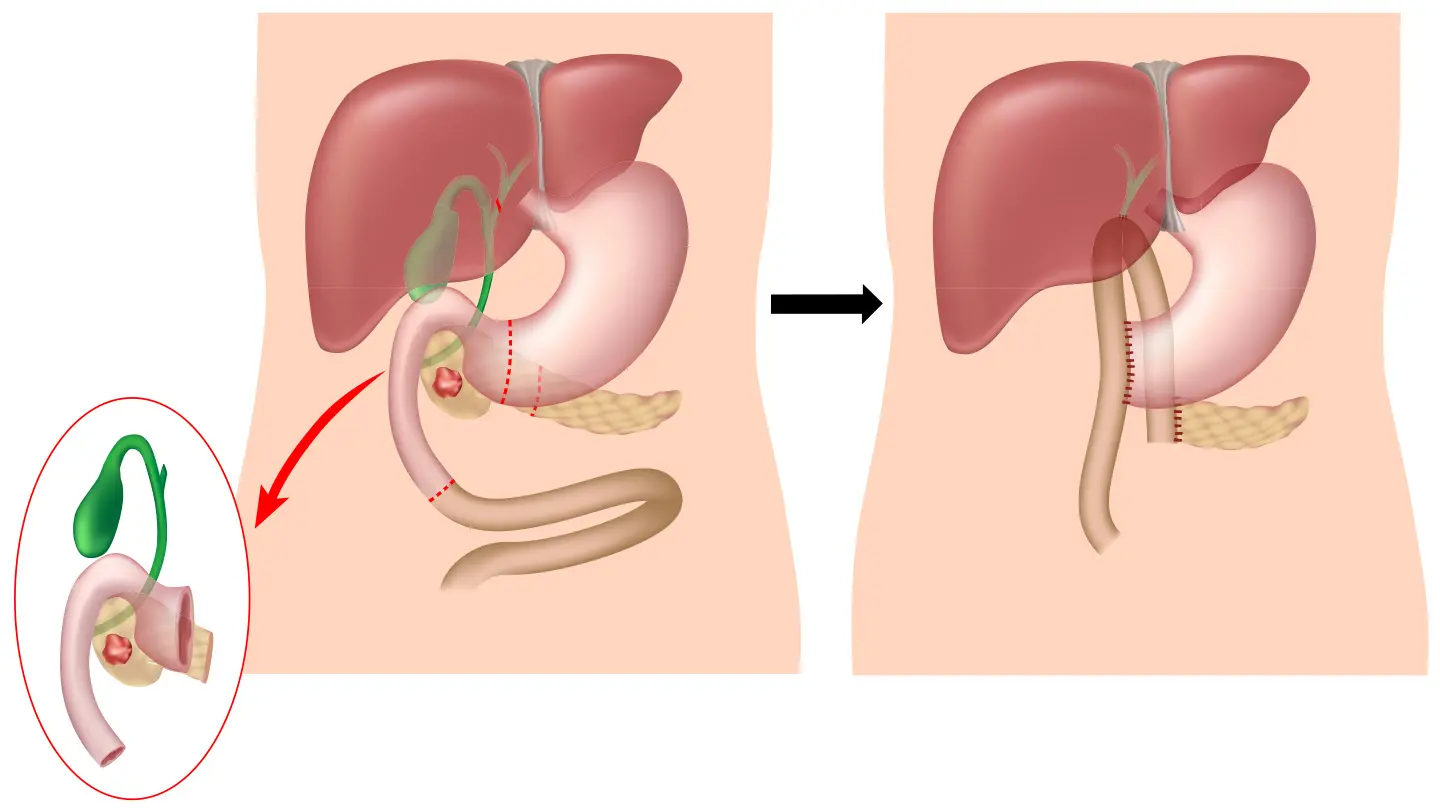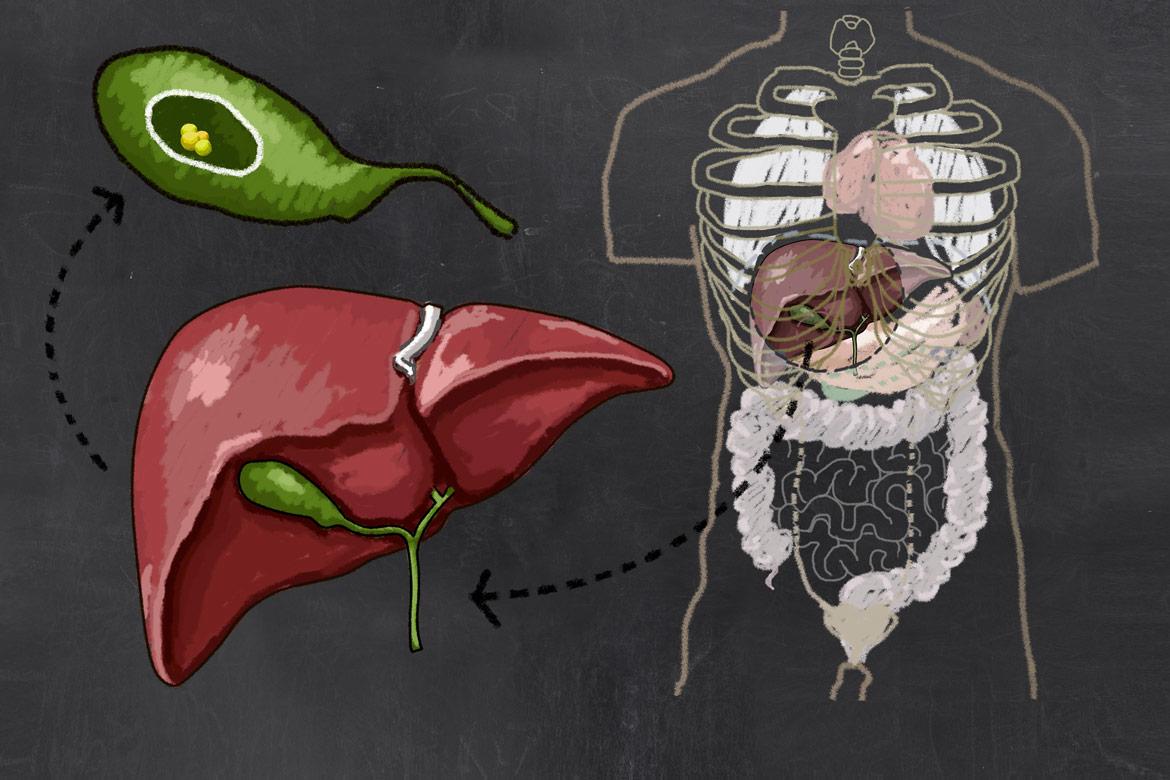What is Whipple procedure?
Whipple procedure, also called pancreaticoduodenectomy, is a surgical procedure to treat pancreatic cancer or bile duct cancer. Its main objective is to remove tumours that are within or around the head of the pancreas.
During a Whipple procedure, the surgeon will remove:
- The head of the pancreas
- The duodenum, which is a part of the small intestine
- A portion of the bile duct
- The gall bladder
In some cases, the surgeon will also remove:
- The body of the pancreas
- A portion of the stomach
After removing these affected internal organs, the surgeon will connect the remaining intestine, bile duct and pancreas.
This procedure is named after Dr Allen Whipple, the first American surgeon to perform the operation in 1935.

Why do you need a Whipple procedure?
Removing a tumour in the pancreas via a Whipple procedure is the best chance for long-term management of pancreatic cancer.
This procedure is suitable only if the tumour is confined to the head of the pancreas. As the risks of Whipple procedures are high, your surgeon will likely order intensive tests to determine your eligibility before going ahead with the surgery.
Who should not undergo Whipple procedure?
A Whipple operation is not suitable if the tumour has spread to the:
- Abdominal cavity
- Body or tail of the pancreas
- Liver
- Lungs
- Major blood vessels
What are the risks and complications of a Whipple procedure?
The Whipple procedure is a highly complex and risky surgery. Death rates vary between 1 – 15% according to the experience of the surgeons.
Patients who undergo a successful Whipple procedures have up to a 25% chance of surviving for 5 years after being diagnosed with pancreatic cancer. Without a Whipple procedure, their 5-year survival rate is only 6%.
Possible complications of a Whipple procedure include:
- Bleeding
- Diabetes
- Digestive problems
- Infections
- Pancreatic leak
- Weight loss
How do you prepare for a Whipple procedure?
Patients who undergo Whipple procedure typically lose weight drastically due to the impact of the surgery on their digestive systems. If possible, you should try to gain weight before the operation. Do focus on eating a healthy and balanced diet. You can consult our dietitians if you need customised advice.
In general, you should make pre-operative lifestyle changes to strengthen your body and lower your chances of facing complications. These changes include:
- Avoiding or reducing your alcohol intake
- Exercising more often
- Quitting smoking
Discuss with your surgeon on the medications that you are currently taking. You may need to stop taking some of them in the days leading to your operation to reduce chances of complications. In addition, your surgeon may prescribe other types of medications to facilitate the procedure.
What can you expect in a Whipple procedure?
A Whipple surgery is a major operation that typically requires 2 – 3 months of recovery.
Estimated duration
6 hours on average.
Before the procedure
You will need to take the following precautionary steps from the day before your procedure:
- Fast from food and drinks, including water, from the night before your surgery.
- Take the medications prescribed by your surgeon with very small sips of water.
- Shower with Hibicleans before leaving for the hospital.
- Hibicleans is an antiseptic soap used to clean the skin and lower the risks of infection.
- Use it gently over your entire body except for your face, hair and genital area. Use normal soap for your face and hair, and regular shampoo for your hair.
- Avoid applying any lotion, cream, perfume, essential oils, make up, deodorant or cologne after your shower.
- Remove any metal objects, such as jewelry or earrings before surgery.
- Remove any contact lenses, hearing aids, dentures and any prosthetic devices.
Once you have checked into the hospital, an anaesthesiologist will discuss with you on the recommended type of anaesthesia for your surgery to help you relax and offer pain relief during the surgery.
During the procedure
Once the anaesthesia is in effect and you are asleep, the surgical team will insert a breathing tube into your mouth and windpipe to help you breathe during the operation. You will also be administered a catheter to drain urine out during and after the surgery.
Your surgeon will open up your abdomen and perform a thorough inspection to confirm that the cancer has not spread outside the pancreas. Once they are satisfied that there is no spread, they will proceed with the Whipple procedure.
They will begin by removing the following internal organs:
- Gall bladder
- Head of the pancreas
- A section of the bile duct
- Duodenum
- (If the cancer has spread) Part of the stomach
- (If the cancer has spread) Body of the pancreas
Next, your surgeon will perform reconstructive surgery to connect the remaining internal organs together. This means attaching:
- The stomach to the small intestine
- The tail of the pancreas to the end of the small intestine or stomach
- Remainder of the bile duct to the small intestine
When this is complete, your surgical team will close up your incisions and transfer you to the intensive care unit where you will be monitored closely for the next 1 – 2 days.
After the procedure
You will likely remain in hospital for 7 – 10 days after your Whipple procedure as your body will need several days to heal from the surgery.
Your surgeon will monitor for complications and your progress in being able to eat and drink again.
They will also order tests to check for bleeding, infection, liver and kidney function and pancreatic leak.
The most common complication after a Whipple procedure is the stomach taking too long to empty its contents. If your stomach takes longer than 7 – 10 days to empty itself, you may need to be fed through a feeding tube for several weeks.
Care and recovery after a Whipple procedure
On average, it takes about 6 – 8 weeks for a patient to recover from a Whipple procedure.
During this post-surgery recovery period, you may require:
- Pain medications to help reduce pain and discomfort
- Small servings of easily digestible food
- Pancreatic enzymes supplements to help your body with digestion
To care for your incision:
- Keep your bandages on for 1 – 2 weeks, until your doctor tells you they can be removed
- Wash the area around your incision with mild soap and water
- Keep your incision covered to keep it clean
Contact your doctor if you have:
- A fever over 38°C
- Redness or pain that worsens over time
- Excessive drainage of blood or other liquid
- No bowel movement for 3 or more days
- Frequent bowel movements or diarrhoea
- Persistent nausea or vomiting
- Vomiting blood or passing black stools
During your follow-up appointments, the doctor will:
- Examine your incision site
- Remove staples and tubes when appropriate
- Review medical reports and pain management
- Assess your diet and bowel function
- Offer advice where needed, such as on diet, wound care and lifestyle
Conditions you may experience
After a Whipple procedure, you may find yourself experiencing the following conditions:
- Chronic fatigue
- Diabetes
- Diarrhoea
- Digestion problems
- Food intolerance
- Stomach-related discomfort such as flatulence, bloating, and cramps
Lifestyle changes
In the long term, you will need to make the following lifestyle changes to boost your health. These include:
- Eating a healthy and balanced diet
- Avoiding deep fried and greasy foods
- Increasing your intake of vegetables and fruits
- Exercising regularly
- Aiming for 150 minutes of moderate to vigorous physical activity each week
- Doing strength training exercises twice a week











